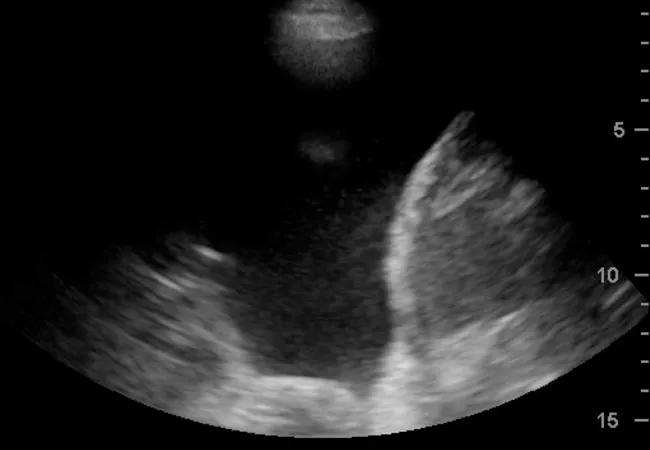What is the diagnosis?
By Adam Alter, MD, Neal Chaisson, MD, Sudipto Mukherjee, MD, MPH, Thomas Gildea, MD
Cleveland Clinic is a non-profit academic medical center. Advertising on our site helps support our mission. We do not endorse non-Cleveland Clinic products or services. Policy
A 68-year-old man with a history of chronic myelogenous leukemia (CML) presents with a history of two months of dyspnea with exertion but without cough, fever, weight gain, orthopnea, chest pain or edema. He has taken dasatinib since his diagnosis of CML five years ago. Recent BCR-ABL1 assay shows no detectable disease. He reports no prior heart or lung disease. QuantiFERON® Gold test from one year ago was positive, and he has not received treatment. He does not smoke and rarely drinks. In addition to dasatinib, medications include levothyroxine, tamsulosin, rosuvastatin and dutasteride.
His vitals are normal with oxygen saturation of 97 percent on room air and decreased breath sounds over the left chest base. A metabolic panel, CBC and ECG were all normal.
His chest radiograph shows a left-sided pleural effusion.

Left chest ultrasound confirms a large, anechoic pleural effusion.

He is referred for thoracentesis, which yields 2,500 mL of dark red, slightly turbid liquid. His cell count shows RBC of 7,000 μL. Nucleated cells are 4,900 μL with 76 percent lymphocytes, 14 percent mesothelials, 5 percent monocytes, 4 percent neutrophils and no eosinophils. Cytology and microbial studies are negative, and triglycerides measure 14 mg/dL.
An isolated pleural effusion without evidence of associated lung parenchymal injury presented a diagnostic challenge. Since the initial thoracentesis did not show evidence of malignancy or TB pleurisy, we suspected dasatinib-associated pleural effusion. Dasatinib is one of many drugs that can cause pleural disease, including other tyrosine kinase inhibitors (TKIs), antineoplastic therapies, nitrofurantoin and amiodarone. Effusions associated with dasatinib typically show elevated lymphocytes in the exudate. Without a definitive test to establish its presence, dasatinib-associated pleural effusion remains a diagnosis of exclusion.
Dasatinib, a BCR-ABL1 TKI, can restore almost normal life expectancy in patients with CML, but patients sometimes develop large granular lymphocytosis in the peripheral blood caused by a clonal expansion of NK and T cells. Patients with this development are more likely to experience pleural effusion, with cytologically identical lymphocytes in the pleural fluid and peripheral blood.
We switched his dasatinib to imatinib and did not administer diuretics and steroids given the lack of evidence of inflammation or volume overload. However, his effusion persisted, prompting three thoracenteses over the next three months, all without evidence of cancer, infection or chylothorax. Seven months after initial presentation, radiographs show a persistent effusion with no need for drainage for four months.
While this patient’s effusion is slow to resolve, we sought to avoid unnecessarily morbid interventions such as indwelling pleural catheter placement or biopsy. First-line treatment for patients with dasatinib-associated effusions should include dose reduction, temporary interruption and transition to an alternative TKI, with thoracentesis to exclude alternative causes and relieve dyspnea.
Images are republished with permission from Alter et al in Chest.
Dr. Alter is a fellow in the Respiratory Institute. Dr. Chaisson is staff in the departments of Pulmonary Medicine and Critical Care Medicine. Dr. Mukherjee is staff in the Department of Hematology and Medical Oncology. Dr. Gildea is staff in the Transplantation Center and departments of Pulmonary Medicine and Critical Care Medicine.

An underdiagnosed condition in patients with cancer

Study demonstrates superior visualization of occult primary lesions

New device offers greater tumor control for malignant liver lesions

Cleveland Clinic researchers discover what drives – and what may halt – virus-induced cancer

First-ever U.S. population-level retrospective analysis reveals many patients with systemic mastocytosis need faster intervention

New program provides prehabilitation and rehabilitation services to help patients with cancer maintain and regain function

First-of-its-kind research investigates the viability of standard screening to reduce the burden of late-stage cancer diagnoses

Global R&D efforts expanding first-line and relapse therapy options for patients